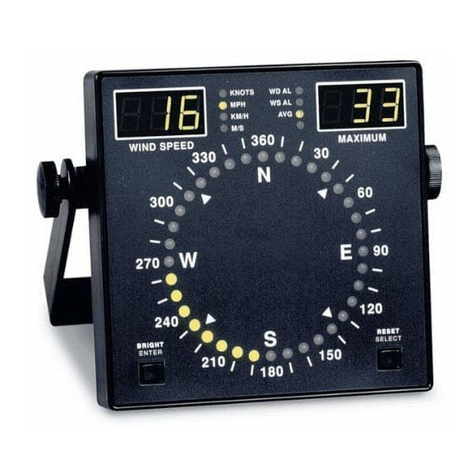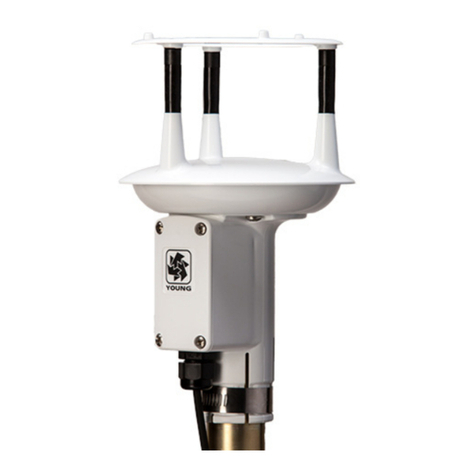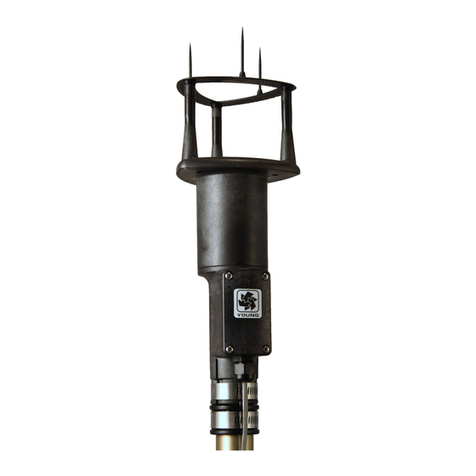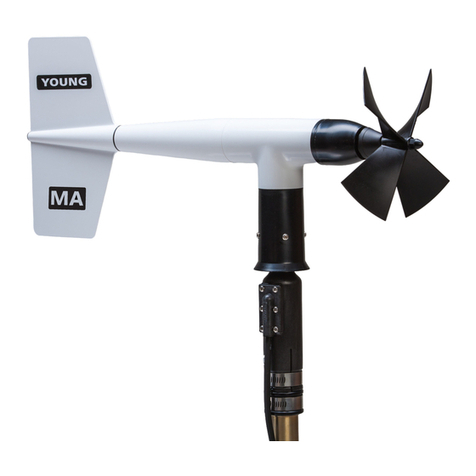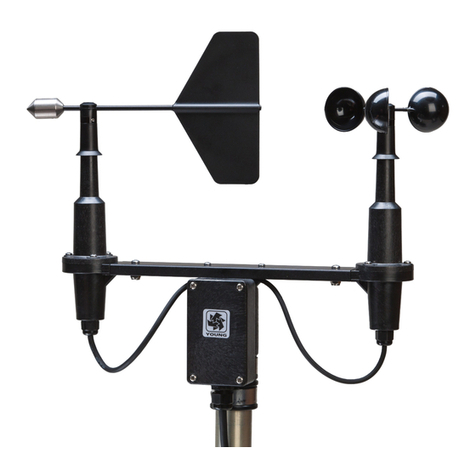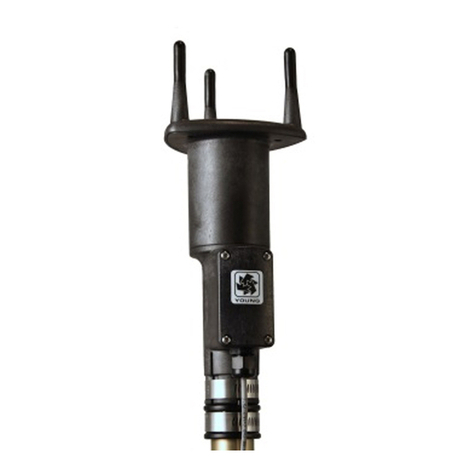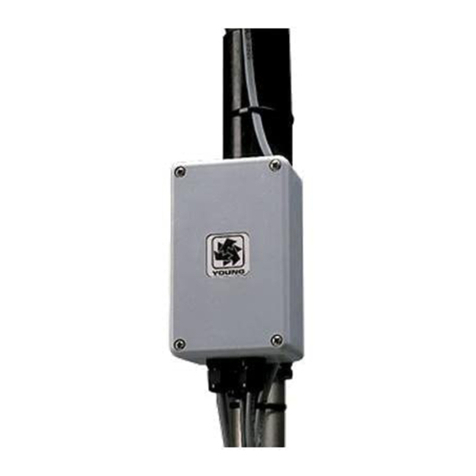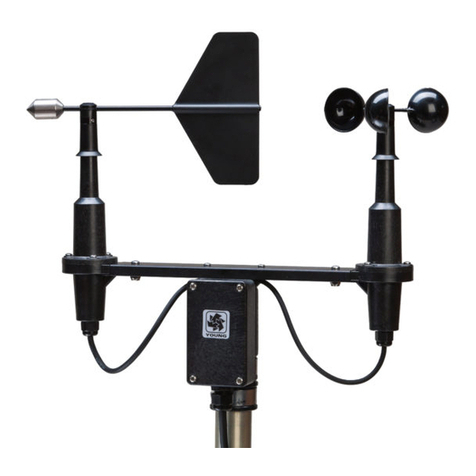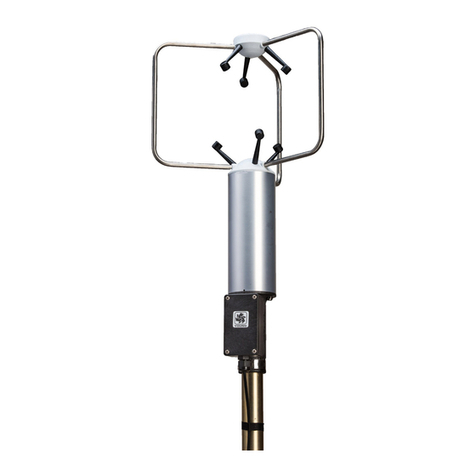
3.
6.5 SCALINGMULTIPLIER
SCALING MULT sets overall scaling for UVW, 2D, and 3D wind
speed outputs. Azimuth and elevation angle are not effected. The
default value of 10000 represents a scaling multipler of 1.0000.
Normally, this value should not be changed since each instrument is
calibrated in the YOUNG factory wind tunnel. However, users who
wish to alter the scaling based on independent calibration
assesment may use this parameter to do so.
SCALING MULT : 10000
ENTER NEW VALUE:
6.6 OUTPUTRATE
OUTPUT RATE sets the rate at which output samples are available.
Fast output rates and long serial output strings may require
higher baud rates in order to keep up with the outgoing data stream.
If AVERAGING is used, average results are available only after
enough output samples have been collected. See AVERAGING for
details.
OUTPUT RATE 4Hz
--------------------
A) 4 HZ
B) 5 HZ
C) 8 HZ
D) 10 HZ
E) 16 HZ
F) 20 HZ
G) 32 HZ
X) EXIT TO MAIN MENU
When using the RS-485 communication with higher output rates and
long output strings, the half-duplex scheme will spend more of its
time sending data with a progressively smaller window of time in
which to receive commands. In fact, if the string is long enough and
the output rate high enough, the 81000 will not be able to respond
to any commands. RS-485 is best used in POLLED MODE or at
modestoutputrates.Incontrast,the full-duplex nature of the RS-232
scheme is immune to the limitations described above. Commands
can be received while data is being sent.
6.7 POLLCHARACTER
POLL CHARACTER (ADDR) is used to set the address character
polledoperation(POLLCUSTOMoutputformat).AnyprintableASCII
character may be used to assign an address that uniquely identifies
the instrument. When bussed on an RS-485 network with other
81000 instruments, each one should have a different address
character.
POLL CHARACTER (ADDR) : A
ENTER NEW CHARACTER:
Topollthe81000,sendMA!whereAisthe POLLCHARACTER.The
81000 will respond with the POLL CHARACTER and a space
followed by the custom serial output string.
6.8 SERIALOUTPUT FORMAT
SERIAL OUTPUT FORMAT sets the output string for serial output.
Preset and custom formats are available.
SERIAL OUTPUT FORMAT 1
------------------------------------
1) CUSTOM
2) RMYT
3) NMEA
4) POLL CUSTOM
X) EXIT TO MAIN MENU
6.8.1 CUSTOM
CUSTOM format allows the user to construct an ASCII-printable
serial output string. Long strings may require higher BAUD rates or
lowerOUTPUT RATES.(See BAUDandOUTPUTRATE.)Also, see
UNITS.
When CUSTOM is selected the following message and sub-menu
appear:
CURRENT SERIAL OUTPUT FORMAT:
34567 [ 3D-SPEED AZIMUTH ELEVATION SOS Ts ]
CONSTRUCT AN OUTPUT FORMAT BY SELECTING FROM THE LIST BELOW.
ELEMENTS MAY BE IN ANY ORDER. REFER TO MANUAL FOR DETAILS.
----------------------------------------------------------
1) UVW
2) 2D SPEED
3) 3D SPEED
4) AZIMUTH
5) ELEVATION
6) SOS
7) Ts
8) ERR CODE
ENTER CUSTOM STRING (8 CHARACTERS MAX): 16
UVW is the orthogonal u, v, and w wind velocities. All three
values are output. Typically the 81000 is oriented with u-axis
aligned east-west and v-axis aligned north-south. In this
orientation, +u values = wind from the east; +v values = wind
from the north. Wind from below (updraft) = +w. Refer to
ORIENTATION KEY drawing for illustration.
2D SPEED is wind magnitude in the u-v plane.
3D SPEED is wind magnitude in three dimensional space.
AZIMUTH is the 0.0-359.9º wind direction angle in the u-v plane.
With the 81000 junction box facing south, 0.0° = north, 90.0° =
east, 180.0° = south, and 270.0° = west. Refer to ORIENTATION
KEY drawing for illustration.
ELEVATION is the ±90.0º wind elevation angle relative to the u-v
plane. Values are positive when wind is from below (updraft)
and negative when from above (downdraft). Effective elevation
angle measurements are limited to ±60.0°. Refer to ORIENTATION
KEY drawing for illustration.
SOS is the speed of sound.
Ts is the sonic temperature derived from SOS.
ERROR CODE indicates the validity of the measurement. Any
non-zero value idicates an invalid measurement. ERROR
HANDLING must be set to use this field.
6.8.2 RMYT
RMYT sends wind speed and direction in a format suitable for use
with the YOUNG Model 06201 Wind Tracker display unit. RS-485
outputs must be used. When RMYT is selected, the baud rate
is automatically set to 9600 and threshold set to 10 cm/sec.
6.8.3 NMEA
NMEA sends wind speed and direction in NMEA marine format to
Young Model 06206 Marine Wind Tracker display or other input
device. The sentence is $WIMWV,aaa,R,ss.s,N,A where aaa =
wind direction angle in degrees and ss.s = wind speed in knots.
When NMEA is selected, the baud rate is automatically
changed to 4800 and threshold set to 10 cm/sec.
